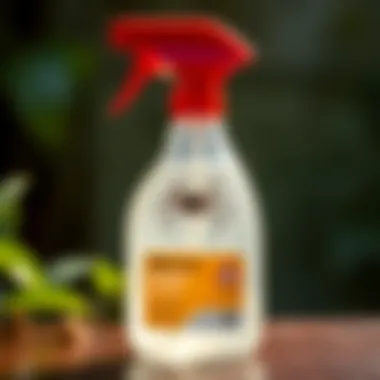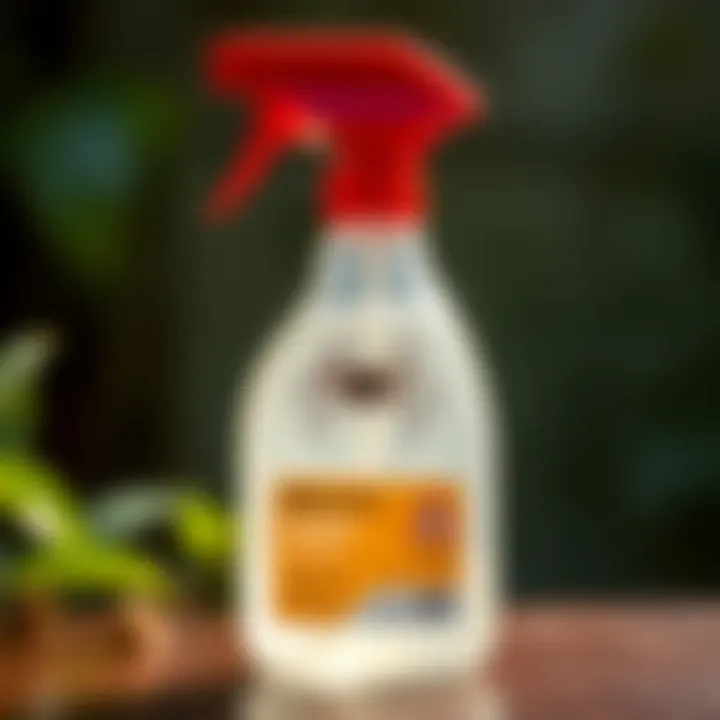Top Spider Sprays: Identification and Use Guide


Intro
Within the corners of our homes, occasionally, an unlikely tenant may set up shop—the spider. While their presence can send many into a panic, understanding these eight-legged creatures can be invaluable. Instead of merely reacting in fear, homeowners should look towards informed decision-making when it comes to managing spider populations. This guide aims to delve deeply into the identification, prevention, and control of spider infestations. With careful consideration of the sprays available in the market, homeowners can effectively reclaim their space while ensuring safety and environmental responsibility.
Understanding the Pest
A deep understanding of spiders is crucial for effective pest control. Not only do spiders serve an ecological purpose by controlling insect populations, but identifying them can also help determine the risk they might pose.
Identification
When it comes to identifying spiders, it is essential to recognize distinguishing features. Spiders exhibit varying colors, sizes, and characteristics. For instance, the harmless House Spider is often light brown with a round body, while the more concerning Brown Recluse portrays a darker shade and has a violin-shaped marking on its back. Here are some tips to help identify common household spiders:
- House Spider: Small, typically brown, often found in undisturbed areas.
- Brown Recluse: Darker, with a distinctive fiddle marking on cephalothorax.
- Black Widow: Recognizable by its glossy black body and red hourglass marking on the abdomen.
Knowing these key traits helps homeowners make smarter choices when applying sprays, ensuring they target the right pests effectively.
Life Cycle
Understanding the life cycle of spiders also plays a significant role in pest control strategies. They undergo the typical stages of Egg, Immature, and Adult. For example, a female spider can lay dozens of eggs, leading to a rapid increase in population if not adequately managed. This means preventive measures can be more effective during warmer months before they reach maturity.
- Eggs: Laid in silk sacs, which can sometimes be found in corners.
- Immature: After hatching, juvenile spiders may leave the egg sac and are often mistaken for adult spiders.
- Adult: Spiders reach maturity within a few weeks to several months, depending on the species.
Pest Prevention Strategies
A proactive approach often helps avoid infestations. This means modifying your environment and employing physical barriers.
Environment Modification
Adjustment of one's environment can drastically lower spider visibility. Here are some common practices:
- Declutter Spaces: Keeping areas free of clutter discourages spider habitation.
- Seal Cracks and Gaps: Use caulk or other materials to close small openings around windows and doors.
- Remove Webs: Clean out existing webs regularly to deter spiders from settling in.
Physical Barriers
Implementing barriers can reduce spider entry into homes. Consider protective measures:
- Screens on Windows: Ensure screens are intact and free from holes, allowing fresh air without pests sneaking in.
- Door Sweeps: Install sweeps at the bottom of doors to limit access.
Control Methods
While prevention is key, control methods may still be necessary when faced with an infestation.
Chemical Control
Chemical sprays are popular and can effectively eliminate spiders if used correctly. However, understanding the specifics of each spray is critical:
Some sprays are intended for indoor use, such as Raid Ant and Roach Killer, which also targets spiders. Others, like Ortho Home Defense Insect Killer, are designed for outdoor application, creating a protective barrier around your property.
Biological Control
Looking into biological controls provides a more eco-friendly option. Introducing beneficial predators, like certain wasps, can help control spider populations without chemicals. Additionally, using essential oils, such as peppermint oil diluted in water, can repel spiders naturally.
"Keeping spiders at bay doesn’t have to involve harmful chemicals if you choose the right natural deterrents."
By understanding the various methods available, including both chemical and biological approaches, homeowners can tackle spider problems sustainably and effectively. As you explore the different options, remember that knowledge is the key to empowered pest control.
Prelims to Spider Control
Spider control is not just a matter of keeping your dwelling free from creepy crawlers; it’s about understanding the bigger picture of pest management. The presence of spiders in your home can often indicate an imbalance in your indoor ecosystem, and it’s crucial to tackle this with an informed approach. With the right knowledge and tools, homeowners can take proactive measures, ensuring their living spaces are both comfortable and safe.
Why Understand Spider Infestations?
To truly grasp the impact of spider infestations, one must recognize that not all spiders are harmful. Some act as natural pest controllers, keeping other insect populations in check. However, when spiders become numerous, or if venomous species are involved, issues can arise. Knowing how to identify these creatures and their nesting habits proves essential for effective control.
Understanding spider infestations and how to manage them effectively provides a solid foundation for any pest control strategy. This knowledge empowers homeowners to discern when intervention is necessary and when to adopt a wait-and-see policy.
Effective Pest Management
Effective pest management hinges on more than just sprays and traps. It combines a thorough understanding of behavior, habitat preferences, and even the life cycles of these spiders. When residents are armed with knowledge about what attracts spiders, they can make informed choices to mitigate risks and minimize infestations.
Homeowners should also recognize that effective spider control is about integrating multiple approaches. This includes maintaining cleanliness, sealing entry points, and where appropriate, applying the right spider sprays. Choosing a spray that fits your specific circumstances can make all the difference in managing a spider problem effectively.
Gaining insights into effective pest management practices equips you with the tools to tackle spider infestations reactively and proactively, ensuring your home remains a sanctuary against unwelcome guests.


"An ounce of prevention is worth a pound of cure."
This traditional saying holds particularly true in pest management, emphasizing the importance of taking preventive steps before an issue escalates.
By grasping both the nature of spider infestations and the principles of pest management, homeowners can maintain a healthy and pleasant living environment.
Types of Common Household Spiders
Understanding the types of spiders that typically invade homes is crucial for effective pest management. Identifying common species not only helps homeowners respond appropriately but also enables them to implement better preventive strategies. Different spider species have varied behaviors, preferred habitats, and feeding habits, which influence how one should approach spider control. Knowledge of these differences can save time and resources when it comes to selecting the right kind of spider spray or other pest control methods.
Identifying Common Spider Species
Identifying the common household spiders requires a keen eye and a bit of knowledge about their characteristics. Here are several key species often found within our homes:
- Black Widow (Latrodectus spp.)
Recognizable by their shiny, jet-black bodies and the distinctive red hourglass marking on the abdomen, black widow spiders are known for their potent venom. These spiders typically reside in secluded, dark areas such as garages or garden sheds. - Brown Recluse (Loxosceles reclusa)
The brown recluse has a violin-shaped marking on its back, which can help in identifying it. This species prefers warm, dry areas and often hides in shoe boxes or under furniture. Its bite can lead to significant skin issues and requires immediate medical attention. - Common House Spider (Parasteatoda tepidariorum)
Usually light tan to gray with a mottled appearance, this spider is often mistaken for others due to its size and simplicity. They create webs in corners and are harmless, primarily feeding on household pests like flies and moths. - Cellar Spider (Pholcus phalangioides)
With long legs and a delicate appearance, cellar spiders are also known as "daddy longlegs." They tend to hang out in secluded corners, utilizing their webs to catch other insects. Notorious for their non-aggressive nature, these spiders can help keep other pest numbers in check. - Wolf Spider (Lycosidae family)
Unlike many spider species, wolf spiders do not spin webs. They're agile hunters and can be found lurking in grass or along walkways. Their large size and hairy bodies can be alarming, but they are generally not dangerous to humans.
By familiarizing oneself with these common species, homeowners can better assess their environments and take necessary action when infestation occurs. Equally, understanding their behaviors gives insights into the best times and methods for applying spider sprays.
Behavioral Patterns of Spiders
Understanding the behavioral patterns of household spiders can significantly enhance your control strategies. Here are some key aspects to consider:
- Hunting vs. Web Spinning
Different spiders approach their prey differently. For example, black widow and common house spiders prefer to build webs to ensnare insects, while wolf spiders actively hunt them down. This knowledge influences the type of spray and method of application. - Activity Patterns
Spiders tend to be more active at night, especially the hunting types. If infestation is suspected, it may be wise to observe areas at dusk to plan a more effective spray application when they are most active. - Habitat Preferences
Wilson's paper suggests tailoring your pest management approach by understanding where each species prefers to dwell. Brown recluse spiders, for example, may seek out dark, undisturbed corners, while cellar spiders may thrive in basements or garages. Knowing these details allows homeowners to strategically apply sprays in high-risk areas.
A focus on spider behavior can greatly improve pest management efforts. As you learn to identify them and understand their habits, tackling spider invasions becomes less daunting.
Criteria for Selecting a Spider Spray
Selecting an effective spider spray is not merely a task of grabbing the first can off the shelf. It involves understanding specific elements that ensure effectiveness, safety, and environmental stewardship. This guide will dissect key considerations that homeowners must evaluate when choosing a spider spray.
Safety Considerations for Pets and Children
One of the primary concerns when selecting pest control products is the safety of family members, particularly pets and children. Many commercial spider sprays contain potent chemicals that, while effective against pests, can pose risks to those who inadvertently come in contact with them. Always look for sprays that are labeled pet-safe and non-toxic to humans. Brands that emphasize natural ingredients can often be a go-to choice. It may require some digging, but reading through product reviews from other parents or pet owners can yield invaluable insights into safety.
- Read labels carefully: Products with clear safety instructions are essential. Be wary of vague warnings or confusing statements that may indicate potential risks.
- Consider age appropriateness: Some sprays may be safer for older children than for toddlers. Consider the mobility of littl'uns when choosing a spray.
- Choose wisely: There are several eco-friendly options that still get the job done without harsh chemicals.
Educating oneself on these matters can make all the difference and allows you to maintain a safe home while tackling spider-related issues.
Effectiveness Against Various Spider Species
Different spider species require different approaches, making this a crucial factor in your choice of spray. Not all sprays are created equal; each has active ingredients that target specific types of spiders. For example, a formulation that effectively repels Black Widow spiders may not be formulated to deal with house spiders or Daddy Long-legs.
When reviewing sprays, take note of the specified ingredients and their efficacy. Here are a few examples:
- Permethrin: Often touted for its wide usage against many spiders, this chemical disrupts nerve function.
- Boric Acid: A slower acting solution, best for those who prefer a more natural alternative but can be effective against various species over time.
Understanding these points will allow homeowners to select a product tailored to their specific spider problem and avoid unnecessary frustration.
Environmental Impact of Ingredients
The conversation around pest sprays is evolving, with increased emphasis on ecological preservation. Many of the conventional spider sprays contain potent chemicals that can detrimentally affect surrounding wildlife and water sources, not to mention causing potential harm to our own health. When selecting a spider spray, consider the environmental impact of its ingredients.
- Research ingredients: Familiarize yourself with the components in any spray. Some may include synthetic chemicals that linger in the environment long after application.
- Opt for natural alternatives: Ingredients derived from plant sources, such as neem oil or diatomaceous earth, can often offer effective pest control without harming beneficial insects or plants.
- Check for certifications: Products with a certification from an environmental agency or organization often indicate a level of safety for the ecosystem.
Shifting to eco-friendly sprays is not just about personal responsibility; it’s about ensuring the well-being of the Earth we all share.
Remember: A safer pest control product is always a better choice, aligning with best practices in maintaining health, safety, and the environment.
Top Spider Sprays on the Market
Selecting the right spider spray is crucial for effective pest management. The market is flooded with various options, making it vital to understand which sprays deliver results and are safe for your household members. Whether you favor chemical or natural treatments, knowing their unique characteristics can help you pick the spray that best fits your needs. In this section, we’ll delve deeper into the types of spider sprays available, examining their active ingredients, application techniques, and eco-friendly alternatives.
Chemical-Based Spider Sprays
Active Ingredients and Their Functionality
When considering chemical-based spider sprays, it’s crucial to know what’s inside the bottle. Common active ingredients include pyrethroids, such as permethrin and bifenthrin, which are synthetic forms of naturally occurring insecticides. These components disrupt the nervous systems of spiders, leading to quick and effective elimination.
This characteristic makes them a popular choice for immediate results where infestations are visible. However, it’s essential to consider the safety of these ingredients. Although they are effective, their impact on non-target species raises concerns. Certain individuals may experience sensitivities, especially those with pets or children at home.
Advantages


- Quick Action: Targets spiders effectively, often killing on contact.
- Widely Available: Easily found in many stores or online.
Disadvantages
- Potential Toxicity: May pose health risks if inhaled or ingested.
- Environmental Concerns: Can affect beneficial insects if not applied carefully.
Application Techniques
Applying spider sprays correctly is critical for their effectiveness. There are two fundamental approaches: spot treatment and perimeter application. Spot treatments are used directly on visible spider populations, ensuring rapid action. Conversely, perimeter applications create a barrier that helps to deter spiders from entering your home.
The key to effective application is ensuring even coverage without saturating any one area. Using a sprayer with adjustable settings enhances control, making it easier to avoid overuse. A disadvantage lies in potential over-application which could lead to increased health hazards or environmental impact.
Unique Features
- Target-Specific: Allows users to focus on problem areas, minimizing unnecessary exposure to non-target species.
- Barrier Methods: A well-applied perimeter spray can significantly reduce spider presence for an extended time, effectively keeping your home spider-free.
Natural and Eco-Friendly Sprays
Botanical Extracts and Their Effectiveness
The rise in demand for natural spider sprays has led to a variety of botanical solutions that utilize plant extracts. Ingredients such as peppermint oil, neem oil, or citrus extracts are common. These sprays are known for repelling spiders, making them suitable for homeowners looking for a non-toxic approach.
A key characteristic of these natural options is their dual purpose; not only do they ward off spiders, but they also provide a more pleasant scent in the home. However, while botanical extracts can deter spiders effectively, they may not kill them instantly, requiring more frequent reapplications than chemical sprays.
Advantages
- Non-Toxic: Safe for pets and children, reducing health concerns.
- Pleasant Scents: The aroma can freshen your home while keeping spiders at bay.
Disadvantages
- Shorter Longevity: Natural extracts may require frequent reapplication, especially in outdoor settings or areas with heavy spider activity.
- Less Immediate Effect: May not eliminate spiders as rapidly as chemical alternatives.
Comparative Analysis with Chemical Options
It's essential to weigh the benefits and drawbacks of both chemical and natural sprays. Chemical sprays might offer instant results when confronted with severe infestations, while natural alternatives provide peace of mind without added toxins. This comparative analysis allows homeowners to reflect on their priorities.
For those prioritizing safety and eco-friendliness, natural sprays present a worthwhile option. Yet if immediate action is of utmost importance, chemical sprays may be the way to go. Assessing the individual circumstances and the severity of the spider issue will guide decisions.
Advantages and Disadvantages Summary
- Chemical Options: Quick results but potential health risks.
- Natural Options: Safe for environments, but may lack immediate effectiveness.
Consider visiting EPA's website or looking into forums like Reddit for real-life experiences and recommendations from other homeowners facing similar problems. Despite their differences, both categories of sprays demand careful application and consideration of your household environment to ensure the best outcomes.
How to Properly Apply Spider Spray
Applying spider spray effectively can be the difference between a peaceful home and a creepy-crawly nightmare. This section delves into the nitty-gritty of how to apply spider spray properly. Understanding the nuances of preparation, the right techniques during application, and post-application considerations is crucial for homeowners aiming to maintain a spider-free environment.
Preparation Steps Before Application
Before you dive in with the spray bottle, it’s essential to take a few preparatory steps to ensure that your pest control efforts are successful. Here are key points to keep in mind:
- Assess the Infestation: Knowing your enemy is half the battle. Take stock of where you see spider webs or sightings. That’ll guide you in directing your spray effectively.
- Choose the Right Time: Early mornings or late afternoons are often the best times to apply your spider spray, as spiders are usually more inactive at these times.
- Clear the Area: Remove any items that could be in the way. This includes furniture, plants, or decorations that might obstruct your spray path.
- Wear Protective Gear: A simple precaution, safety goggles and gloves can shield you from any irritation caused by the spray.
- Check the Weather: If you’re spraying outdoors, avoid windy conditions. Sprays can be carried away, reducing their effectiveness and potentially impacting non-target areas.
By following these preparation steps, you set the stage for an effective application process.
Techniques for Effective Application
Once you’re ready, applying spider spray can be straightforward if you keep these techniques in mind:
- Shake Well: Ensure that the contents are mixed thoroughly before applying. This helps in achieving an even distribution of the active ingredients.
- Spray at the Right Distance: Keep the nozzle 12-18 inches away from surfaces. This distance provides a good coverage without over-saturating any one area.
- Target Specific Areas: Focus on cracks, crevices, and corners where spiders are likely to hide. High-traffic areas for pests, like near windows and doors, are prime locations for application.
- Use a Steady Motion: Rather than spraying in short bursts, practice a steady sweep across the area. This helps avoid pooling and ensures an even coat.
- Follow the Guidelines: Adhering to the instructions on the spray label is crucial. It provides specifics about how much and how often to apply.
By employing these techniques, you maximize the effectiveness of your spider spray and minimize the chance of missing spots.
Post-Application Considerations
After you’ve done your spraying, the work isn’t over just yet. Here are a few things to keep in mind after applying the spray:
- Allow for Drying Time: Avoid touching the sprayed areas until they are dry. This prevents the active ingredients from being washed away or transferred onto your hands.
- Secure the Area: Keep pets and kids away from treated zones until you’re sure the area has dried as recommended on the product label.
- Monitor and Reapply: Check back regularly to see if spider activity continues. You might need to reapply periodically, especially after rain if you're treating outdoor areas.
- Clean the Area: Once the treatment has settled, maintaining cleanliness in and around your home helps in keeping spiders at bay. Regular dusting and vacuuming can prevent spiders from setting up shop again.


A consistent application routine is key. If spiders return, don’t hesitate to reassess your techniques or consider consulting a professional pest control service.
Preventative Measures to Avoid Spider Infestations
Taking the right preventative measures can be the game changer in avoiding spider infestations before they begin. Understanding how spiders gain access to our living spaces and what we can do to deter them is crucial. Many homeowners may feel like they’re constantly at war with these eight-legged creatures; however, a few practical steps can make their homes a formidable fortress against spiders.
Identifying and Sealing Entry Points
Spiders, despite their intricate web-making skills, are rather simple when it comes to finding ways in. They sneak through the tiniest cracks and crevices, which is why identifying these entry points is the first line of defense. Common areas to inspect include:
- Windows and Doors: Often, gaps around these areas can be the most accessible routes for spiders. Ensure weather stripping is intact and seals are tight.
- Foundation Cracks: These can often be overlooked; however, even a small crack in the home’s foundation can allow spiders to crawl in.
- Vents: Check for any gaps in wall vents, particularly in attics, since they can leave a pathway directly into your living space.
Once entry points are identified, the next step is sealing them efficiently. Use caulk or expanding foam to fill these gaps, which helps eliminate those unwanted invitations. For larger openings, screens or mesh can create a barrier while still allowing ventilation.
Key Points to Remember:
- Regularly inspect your home for new entry points throughout the changing seasons.
- Don't forget about basement windows and crawl spaces; these often provide an easy access point.
Maintaining a Clean Environment
A clean home is an unwelcoming environment for spiders. Regular cleaning not only keeps your space tidy, but it also minimizes habitats that spiders love to thrive in. Here’s how you can enhance your spider-prevention strategy:
- Declutter: Spiders love dark, hidden places. Reducing clutter, particularly in basements and attics, can take away their hiding spots. Store items in sealed containers when possible.
- Dust and Vacuum: Regularly dusting surfaces and vacuuming can remove spider webs and eggs. Pay close attention to corners and under furniture where spiders like to spin their webs.
- Control Outdoor Debris: Keeping your yard tidy can also affect spider populations. Piles of leaves, wood, or other yard debris are perfect nesting sites. Not to mention, keeping shrubs and plants trimmed back from the foundation can deter spiders from edging close to your home.
Maintaining an organized and clean environment is a sustainable way to prevent spiders from ever getting comfortably settled in.
Remember: A well-kept space doesn’t only look good; it sends spiders packing.
By proactively sealing entry points and maintaining hygiene in your living spaces, you significantly bolster your defenses against spider infestations. These measures might seem simple, but they lay the foundation for an enduring, spider-free household.
Understanding the Limitations of Spider Sprays
When it comes to tackling spider problems in your home, it might seem like a straightforward fix to spray your way to a spider-free sanctuary. However, there's more lurking beneath the surface. Understanding the limitations of spider sprays is crucial for effective pest management. This knowledge not only helps to set realistic expectations but also encourages a multi-faceted approach to dealing with these eight-legged invaders.
It's important to recognize that spider sprays, while effective in many situations, are often not a one-size-fits-all solution. They work primarily on contact and may not reach spiders hidden in crevices or those that have built their webs in hard-to-access areas. Additionally, even the best spider sprays may not have residual effects long enough to prevent re-infestation unless combined with other preventative measures.
When Sprays Should Not Be Your Only Solution
There are moments when relying solely on sprays just won't cut the mustard. For instance, if you face a particularly severe infestation, a spray may only serve as a temporary measure rather than a permanent fix.
Consider these scenarios:
- Nesting Spiders: If you discover a nest or egg sac, sprays might not penetrate the protective silk. In such cases, removal of the nest is essential.
- Prolific Breeders: Web builders such as the black widow or brown recluse can multiply quickly. A point-in-time treatment like a spray doesn't address the root problem, which is the ongoing life cycle of these arachnids.
- Long-term Solutions Needed: Sometimes it’s better to engage in a holistic approach. A good cleaning routine and sealing off entry points might be necessary along with the occasional spray.
"While spider sprays have their place in the pest control arsenal, they are most effective when part of a broader strategy."
Situations Requiring Professional Intervention
Understanding when to call in the cavalry can save you from a world of frustration. Here are a few situations when seeking professional pest control may be the best course of action:
- Severe Infestations: If the spiders have taken over your space to the point where DIY efforts seem futile, it’s time to dial up the experts. They have access to stronger solutions and the know-how to identify which species you’re dealing with.
- Health Concerns: If you (or anyone in your home) have allergies or health issues, certain spiders—like the venomous brown recluse—pose risks. Professionals can assess these risks more effectively.
- Complex Homes: Homes with numerous hiding spots such as basements, attics, or structural voids may require specialized equipment and knowledge for a thorough treatment.
Finale and Final Thoughts
As we draw the curtain on this comprehensive discussion about spider sprays, it’s essential to underscore the significance of the topic at hand. Spider control is not merely about eliminating these eight-legged critters; it’s a multifaceted approach that intertwines safety, efficacy, and sustainability. Understanding how to effectively utilize spider sprays can provide peace of mind for homeowners, making it easier to manage infestations without compromising the safety of loved ones or pets.
Indeed, this guide laid down several key insights. By emphasizing methodologies for proper application, identifying criteria for selecting sprays, and acknowledging when to seek professional help, it empowers individuals to tackle potential spider problems with confidence. This knowledge is not an isolated fragment. Rather, it serves as part of a broader framework of pest management, equipped with a reservoir of strategies and insights designed to enhance overall household comfort.
Remember that spider sprays can vary significantly in their formulations and effectiveness. Selecting the right one hinges on understanding your specific circumstances, including the types of spiders you’re dealing with and the environment in which they reside.
"Knowledge is power. Information is liberating. Education is the premise of progress, in every society, in every family." - Kofi Annan
In closing, embracing an informed approach not only aids in dealing with spider infestations but can ultimately foster a more harmonious living space. With consistent care and proper techniques, the issues posed by unwanted arachnids can be mitigated effectively and responsibly.
Recap of Key Insights
Many pivotal points were discussed, centering around spider sprays. Here are some highlights:
- Types of Spiders: Recognizing whether you're facing a common house spider or a more concerning species is vital for effective control.
- Spray Selection: Consider the safety of pets and children, alongside the environmental impact, when choosing a specific spray.
- Application Techniques: Proper preparation and application techniques can enhance the effectiveness of the sprays used.
- Preventative Measures: Regular maintenance such as sealing entry points and keeping a clean environment significantly lessens the chances of future infestations.
Empowerment Through Knowledge
Armed with information, homeowners can engage in pest management practices that reflect understanding instead of fear. Knowledge about different spider species aids in recognizing friends from foes—while many spiders are beneficial, a few can be a nuisance or harmful.
Moreover, a well-informed choice of spider sprays can lead to successful outcomes without unnecessary health risks. The more aware you are of your options, the more control you have over the living conditions within your home. As the saying goes, "An ounce of prevention is worth a pound of cure"—taking proactive measures can maintain a spider-free environment, ensuring comfort and safety for everyone living under your roof.







